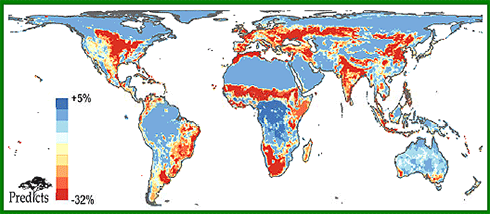Major study shows biodiversity losses can be reversed

Most people would probably agree that human pressures on the land are bad news for wildlife. Practices such as agriculture can introduce pollutants to the environment, force out wildlife, and change local ecosystems forever.
A new study published today in the journal Nature gives a global view of this damage since the 1500s. It shows that by 2005, worldwide land use change had caused a drop of 14 per cent in the average number of species found in local ecosystems. Most of this loss came in the last 100 years.
Some of this damage can be reversed, however. But this would need worldwide action to tackle climate change, specifically establishing a strong carbon market where high biodiversity habitats are given an economic value, say the authors.
First global analysis
The study is the first global analysis of human impacts on local biodiversity. It is a major collaboration between the Natural History Museum, United Nations Environment Programme World Conservation Monitoring Centre (UNEP-WCMC), and British universities.
Scientists submitted data from more than 70 countries and considered 26,593 species, adding more than 1.1 million records to the PREDICTS (Projecting Responses of Ecological Diversity In Changing Terrestrial Systems) survey database.
The team's figure of a 14 per cent drop in species in local ecosystems is a global average. So local biodiversity in some areas is still quite intact, but others - including Western Europe - have had losses of 20-30 per cent.
Tipping point
This is important because 20 per cent is widely considered the tipping point beyond which an ecosystems' ability to provide the natural services like flood protection or control of pest outbreaks are compromised.
'For example as biodiversity declines, outbreaks of crop pests become more likely,' said Andy Purvis, the study's lead scientist and Museum biodiversity expert. 'We can spray crops and spend money to reduce that risk but that is basically compensating for something that biodiversity used to provide before'.
Climate change scenarios
To forecast how human activity would affect biodiversity in the future, the team modelled their data with four climate change mitigation scenarios developed by the IPCC (Intergovernmental Panel on Climate Change).
Most of the scenarios brought bad news. If business-as-usual continued with no action taken to tackle climate change, a further 3.4 per cent of local species would be lost on average across the world. The countries that lose most heavily are the poorest, most biodiverse countries. Another scenario, where primary forest is converted to biofuel plantations, also had a bleak outlook with species continuing to be lost.
However, the team were surprised to see such a positive outlook in the carbon markets scenario, which they say showed that nearly all countries win, even most of the poorest.
Purvis concludes, 'These findings are a significant milestone in understanding our impact on the planet. They show that what happens next is completely down to us.
'If we carry on as we are, numbers of species will fall by nearly 3.5 per cent on average by 2100. But if society takes concerted action, and reduces climate change by valuing forests properly, then by the end of the century we can undo the last 50 years of damage to biodiversity on land.'
More information: "Global effects of land use on local terrestrial biodiversity." Nature 520, 45–50 (02 April 2015) DOI: 10.1038/nature14324
Journal information: Nature
Provided by Natural History Museum


















